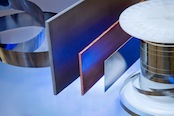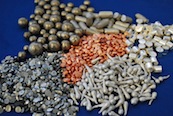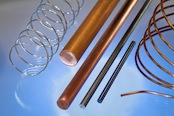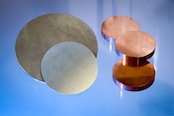Tungsten Selenide
MATERIAL SAFETY DATA SHEET
I. PRODUCT IDENTIFICATION
Manufacturer/Supplier:
ESPI Metals
1050 Benson Way, Ashland, OR 97520
Toll Free (800) 638-2581 * Fax (541) 488-8313
E-Mail: This email address is being protected from spambots. You need JavaScript enabled to view it.
Product Name: Tungsten Selenide
Formula: WSe2
CAS Number: 12067-46-8
II. HAZARDOUS INGREDIENTS
Hazardous Component: Tungsten Selenide
Percent (%): 0-100
OSHA/PEL: 0.2 mg/m3
ACGIH/TLV: 0.2 mg/m3
HMIS Ratings:
Health: 3
Flammability: 0
Reactivity: 0
III. PHYSICAL DATA
Boiling Point: N/A
Melting Point: N/A
Specific Gravity: 9.32 g/cc
Solubility in H2O: Insoluble
Appearance and Odor: Black powder and pieces, no odor
IV. FIRE AND EXPLOSION HAZARDS DATA
Flash Point: N/A
Autoignition Temperature: N/E
Flammable Limits: Upper: N/A Lower: N/A
Extinguishing Media: Use suitable extinguishing media for surrounding materials and type of fire.
Special Fire Fighting Procedures: Firefighters must wear full face, self-contained breathing apparatus with full protective clothing to prevent contact with skin and eyes. Fumes from fire are hazardous. Isolate runoff to prevent environmental pollution.
Unusual Fire and Explosion Hazards: When heated to decomposition, tungsten selenide may emit toxic fumes of selenium.
V. HEALTH HAZARD INFORMATION
Effects of Exposure:
To the best of our knowledge the chemical, physical and toxicological properties of tungsten selenide have not been thoroughly investigated and recorded.
Industrially, tungsten does not constitute an important health hazard. Exposure is related chiefly to the dust arising from the crushing and milling of the two chief ores of tungsten, namely sheelite and wolframite. Large overdoses cause central nervous system disturbances, diarrhea, respiratory failure and death in experimental animals (Sax, Dangerous Properties of Industrial Materials).
Selenium compounds are poison by inhalation and intravenous routes. Some selenium compounds are experimental carcinogens. Long-term exposure may be a cause of amyotrophic lateral sclerosis in humans, just as it may cause "blind staggers" in cattle. Elemental selenium has low acute systemic toxicity, but dust or fumes can cause serious irritation of the respiratory tract. Inorganic selenium compounds can cause dermatitis. Garlic odor of breath is a common symptom. Pallor, nervousness, depression, digestive disturbances and death have been reported in cases of chronic exposure (Sax, Dangerous Properties of Industrial Materials).
Acute Effects:
Inhalation: DANGER-POISON. May cause irritation to the respiratory tract and acute selenium poisoning.
Ingestion: May cause gastrointestinal disturbances.
Skin: May cause irritation.
Eye: May cause irritation.
Chronic Effects:
Inhalation: May cause chronic selenium poisoning. Continued intoxication may cause loss of nails and hair, hemolytic anemia, and kidney, liver and spleen damage.
Ingestion: May cause chronic selenium toxicity. Large overdoses may cause nervous system disturbances and diarrhea.
Skin: May cause dermatitis.
Eye: No chronic health effects recorded.
Target Organs: Upper respiratory and central nervous system, liver, kidneys and blood.
Medical Conditions Generally Aggravated By Exposure: Pre-existing respiratory and skin disorders.
Carcinogenicity: NTP: No IARC: No OSHA: No
EMERGENCY AND FIRST AID PROCEDURES:
INHALATION: Remove victim to fresh air, keep warm and quiet, give oxygen if breathing is difficult and seek medical attention.
INGESTION: Give 1-2 glasses of milk or water and induce vomiting. Keep warm and quiet, seek medical attention. Never induce vomiting or give anything by mouth to an unconscious person.
SKIN: Remove contaminated clothing, brush material off skin, wash affected area with mild soap and water. Seek medical attention if symptoms persists.
EYE: Flush eyes with lukewarm water, lifting upper and lower eyelids, for at least 15 minutes. Seek medical attention if symptoms persists.
VI. REACTIVITY DATA
Stability: Stable
Conditions to Avoid: None
Incompatibility (Material to Avoid): None recorded.
Hazardous Decomposition Products: Fumes of selenium
Hazardous Polymerization: Will not occur
VII. SPILL OR LEAK PROCEDURES
Steps to Be Taken in Case Material Is Released or Spilled: Wear appropriate respiratory and protective equipment specified in section VIII. Isolate spill area and provide ventilation. Vacuum up spill using a high efficiency particulate absolute (HEPA) air filter and place in a closed container for proper disposal. Take care not to raise dust.
Waste Disposal Method: Dispose of in accordance with local, state and federal regulations.
VIII. SPECIAL PROTECTION INFORMATION
Respiratory Protection: NIOSH-approved dust, mist, vapor cartridge respirator
Ventilation: Handle in a controlled, enclosed process. Use local exhaust to maintain concentrations at or below the PEL, TLV. Special: General exhaust is not recommended
Protective Gloves: Rubber Gloves
Eye Protection: Safety Glasses
Other Protective Clothing or Equipment: Protective gear suitable to prevent contamination.
IX. SPECIAL PRECAUTIONS
Precautions to Be Taken in Handling and Storing: Store in cool, dry area. Store in tightly sealed container. Wash thoroughly after handling.
Work Practices: Implement engineering and work practice controls to reduce and maintain concentration of exposure at low levels. Use good housekeeping and sanitation practices. Do not use tobacco or food in work area. Wash thoroughly before eating and smoking. Do not blow dust off clothing or skin with compressed air. Maintain eyewash capable of sustained flushing, safety drench shower and facilities for washing.
TSCA Listed: Yes
DOT Regulations:
Hazard Class: 6.1
Identification Number: UN3283
Packing Group: III
Proper Shipping Name: Selenium compound, solid, n.o.s., (Tungsten Selenide)
The above information is believed to be correct, but does not purport to be all inclusive and shall be used only as a guide. ESPI shall not be held liable for any damage resulting from handling or from contact with the above product.
Issued by: S. Dierks
Revised/Verified: May 2012
 ALLOYS
ALLOYS 





